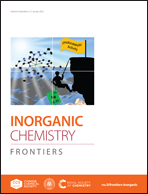Oxygen vacancy distributions and electron localization in a CeO2(100) nanocube †
Abstract
In this work, the oxygen vacancy distributions in a 5 nm CeO2 nanocube were determined via Reverse Monte Carlo (RMC) simulations using neutron total scattering atomic pair distribution function (PDF) data, with further elaboration based on DFT calculations. The results showed that the oxygen vacancies tend to be located towards the surface of the CeO2 nanocube, and the distribution rate of oxygen vacancies suddenly drops in the subsurface region and inside the nanocube. There are two types of vacancies on the subsurface, Ovacsub1 with a surface O atom above it and Ovacsub2 without a surface O atom above it, and the respective proportions are 61.9% and 38.1%. According to the DFT calculations, the remaining two 4f electrons, present on account of oxygen vacancy formation, preferably localize at 1N positions with respect to Ovacsur and Ovacsub2 or at 2N positions with respect to Ovacsub1. Furthermore, it could be concluded that the two excess electrons in the case of CeO2(100) tend to stay in surface or subsurface Ce layers, according to the high proportion of longer characteristic Ce3+–O bond lengths obtained from the Reverse Monte Carlo (RMC) simulations. It should be noted that type-1 subsurface oxygen vacancies, Ovacsub1, are expected to be more probable to aggregate, revealing the characteristic existence of accumulated subsurface vacancies.



 Please wait while we load your content...
Please wait while we load your content...